Jun Sakuma
University of Tsukuba
Toward Safer Diffusion Language Models: Discovery and Mitigation of Priming Vulnerability
Oct 01, 2025Abstract:Diffusion language models (DLMs) generate tokens in parallel through iterative denoising, which can reduce latency and enable bidirectional conditioning. However, the safety risks posed by jailbreak attacks that exploit this inference mechanism are not well understood. In this paper, we reveal that DLMs have a critical vulnerability stemming from their iterative denoising process and propose a countermeasure. Specifically, our investigation shows that if an affirmative token for a harmful query appears at an intermediate step, subsequent denoising can be steered toward a harmful response even in aligned models. As a result, simply injecting such affirmative tokens can readily bypass the safety guardrails. Furthermore, we demonstrate that the vulnerability allows existing optimization-based jailbreak attacks to succeed on DLMs. Building on this analysis, we propose a novel safety alignment method tailored to DLMs that trains models to generate safe responses from contaminated intermediate states that contain affirmative tokens. Our experiments indicate that the proposed method significantly mitigates the vulnerability with minimal impact on task performance. Furthermore, our method improves robustness against conventional jailbreak attacks. Our work underscores the need for DLM-specific safety research.
Explainable Classifier for Malignant Lymphoma Subtyping via Cell Graph and Image Fusion
Mar 02, 2025
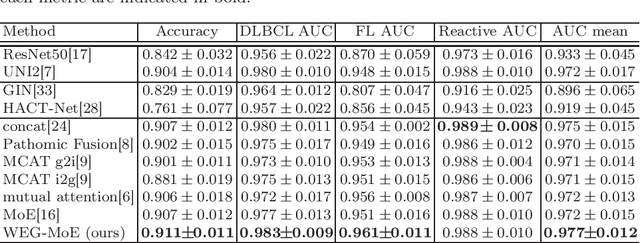
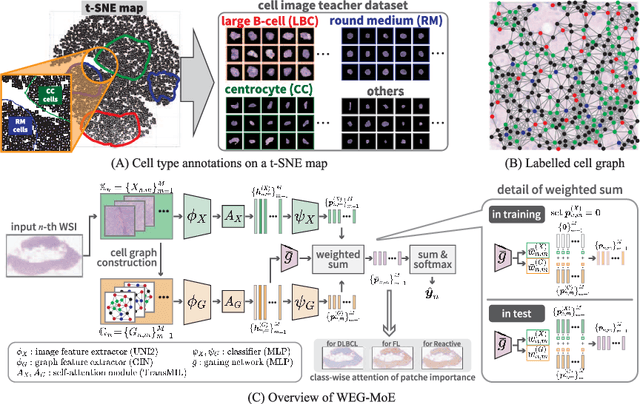
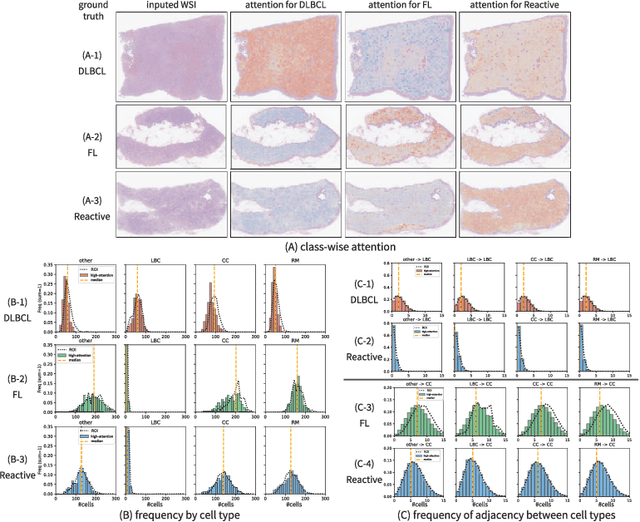
Abstract:Malignant lymphoma subtype classification directly impacts treatment strategies and patient outcomes, necessitating classification models that achieve both high accuracy and sufficient explainability. This study proposes a novel explainable Multi-Instance Learning (MIL) framework that identifies subtype-specific Regions of Interest (ROIs) from Whole Slide Images (WSIs) while integrating cell distribution characteristics and image information. Our framework simultaneously addresses three objectives: (1) indicating appropriate ROIs for each subtype, (2) explaining the frequency and spatial distribution of characteristic cell types, and (3) achieving high-accuracy subtyping by leveraging both image and cell-distribution modalities. The proposed method fuses cell graph and image features extracted from each patch in the WSI using a Mixture-of-Experts (MoE) approach and classifies subtypes within an MIL framework. Experiments on a dataset of 1,233 WSIs demonstrate that our approach achieves state-of-the-art accuracy among ten comparative methods and provides region-level and cell-level explanations that align with a pathologist's perspectives.
BADTV: Unveiling Backdoor Threats in Third-Party Task Vectors
Jan 04, 2025Abstract:Task arithmetic in large-scale pre-trained models enables flexible adaptation to diverse downstream tasks without extensive re-training. By leveraging task vectors (TVs), users can perform modular updates to pre-trained models through simple arithmetic operations like addition and subtraction. However, this flexibility introduces new security vulnerabilities. In this paper, we identify and evaluate the susceptibility of TVs to backdoor attacks, demonstrating how malicious actors can exploit TVs to compromise model integrity. By developing composite backdoors and eliminating redudant clean tasks, we introduce BadTV, a novel backdoor attack specifically designed to remain effective under task learning, forgetting, and analogies operations. Our extensive experiments reveal that BadTV achieves near-perfect attack success rates across various scenarios, significantly impacting the security of models using task arithmetic. We also explore existing defenses, showing that current methods fail to detect or mitigate BadTV. Our findings highlight the need for robust defense mechanisms to secure TVs in real-world applications, especially as TV services become more popular in machine-learning ecosystems.
Parameter Matching Attack: Enhancing Practical Applicability of Availability Attacks
Jul 02, 2024



Abstract:The widespread use of personal data for training machine learning models raises significant privacy concerns, as individuals have limited control over how their public data is subsequently utilized. Availability attacks have emerged as a means for data owners to safeguard their data by desning imperceptible perturbations that degrade model performance when incorporated into training datasets. However, existing availability attacks exhibit limitations in practical applicability, particularly when only a portion of the data can be perturbed. To address this challenge, we propose a novel availability attack approach termed Parameter Matching Attack (PMA). PMA is the first availability attack that works when only a portion of data can be perturbed. PMA optimizes perturbations so that when the model is trained on a mixture of clean and perturbed data, the resulting model will approach a model designed to perform poorly. Experimental results across four datasets demonstrate that PMA outperforms existing methods, achieving significant model performance degradation when a part of the training data is perturbed. Our code is available in the supplementary.
Zero-shot domain adaptation based on dual-level mix and contrast
Jun 27, 2024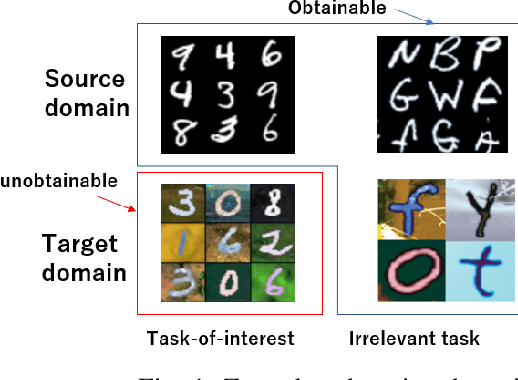

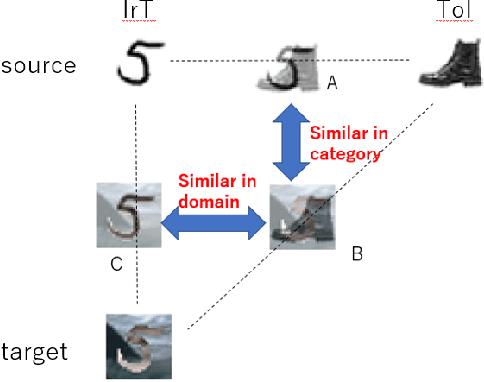
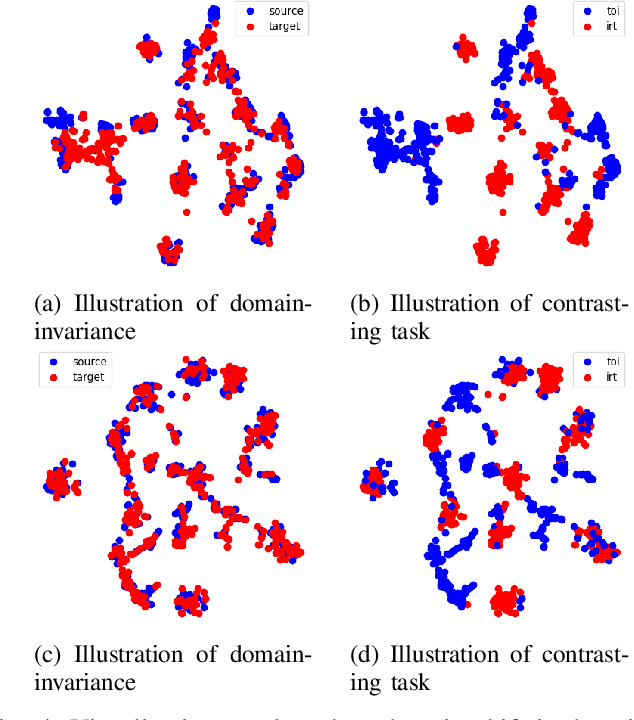
Abstract:Zero-shot domain adaptation (ZSDA) is a domain adaptation problem in the situation that labeled samples for a target task (task of interest) are only available from the source domain at training time, but for a task different from the task of interest (irrelevant task), labeled samples are available from both source and target domains. In this situation, classical domain adaptation techniques can only learn domain-invariant features in the irrelevant task. However, due to the difference in sample distribution between the two tasks, domain-invariant features learned in the irrelevant task are biased and not necessarily domain-invariant in the task of interest. To solve this problem, this paper proposes a new ZSDA method to learn domain-invariant features with low task bias. To this end, we propose (1) data augmentation with dual-level mixups in both task and domain to fill the absence of target task-of-interest data, (2) an extension of domain adversarial learning to learn domain-invariant features with less task bias, and (3) a new dual-level contrastive learning method that enhances domain-invariance and less task biasedness of features. Experimental results show that our proposal achieves good performance on several benchmarks.
Behavior-Targeted Attack on Reinforcement Learning with Limited Access to Victim's Policy
Jun 06, 2024Abstract:This study considers the attack on reinforcement learning agents where the adversary aims to control the victim's behavior as specified by the adversary by adding adversarial modifications to the victim's state observation. While some attack methods reported success in manipulating the victim agent's behavior, these methods often rely on environment-specific heuristics. In addition, all existing attack methods require white-box access to the victim's policy. In this study, we propose a novel method for manipulating the victim agent in the black-box (i.e., the adversary is allowed to observe the victim's state and action only) and no-box (i.e., the adversary is allowed to observe the victim's state only) setting without requiring environment-specific heuristics. Our attack method is formulated as a bi-level optimization problem that is reduced to a distribution matching problem and can be solved by an existing imitation learning algorithm in the black-box and no-box settings. Empirical evaluations on several reinforcement learning benchmarks show that our proposed method has superior attack performance to baselines.
Adversarial Attacks on Hidden Tasks in Multi-Task Learning
May 28, 2024Abstract:Deep learning models are susceptible to adversarial attacks, where slight perturbations to input data lead to misclassification. Adversarial attacks become increasingly effective with access to information about the targeted classifier. In the context of multi-task learning, where a single model learns multiple tasks simultaneously, attackers may aim to exploit vulnerabilities in specific tasks with limited information. This paper investigates the feasibility of attacking hidden tasks within multi-task classifiers, where model access regarding the hidden target task and labeled data for the hidden target task are not available, but model access regarding the non-target tasks is available. We propose a novel adversarial attack method that leverages knowledge from non-target tasks and the shared backbone network of the multi-task model to force the model to forget knowledge related to the target task. Experimental results on CelebA and DeepFashion datasets demonstrate the effectiveness of our method in degrading the accuracy of hidden tasks while preserving the performance of visible tasks, contributing to the understanding of adversarial vulnerabilities in multi-task classifiers.
Harnessing the Power of Vicinity-Informed Analysis for Classification under Covariate Shift
May 27, 2024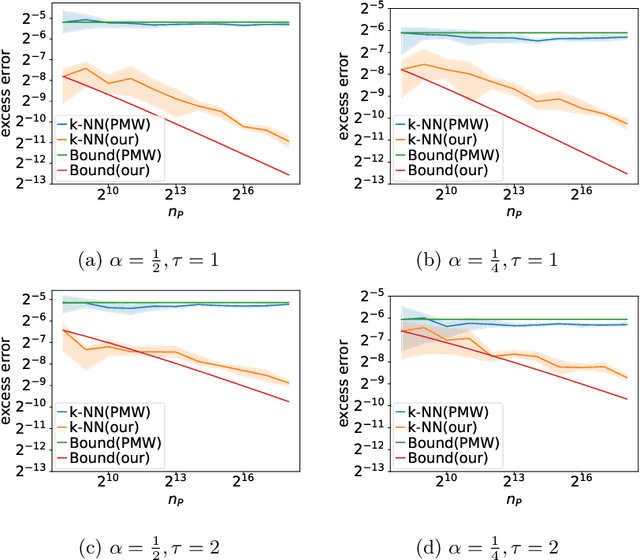
Abstract:Transfer learning enhances prediction accuracy on a target distribution by leveraging data from a source distribution, demonstrating significant benefits in various applications. This paper introduces a novel dissimilarity measure that utilizes vicinity information, i.e., the local structure of data points, to analyze the excess error in classification under covariate shift, a transfer learning setting where marginal feature distributions differ but conditional label distributions remain the same. We characterize the excess error using the proposed measure and demonstrate faster or competitive convergence rates compared to previous techniques. Notably, our approach is effective in situations where the non-absolute continuousness assumption, which often appears in real-world applications, holds. Our theoretical analysis bridges the gap between current theoretical findings and empirical observations in transfer learning, particularly in scenarios with significant differences between source and target distributions.
Remembering Transformer for Continual Learning
Apr 11, 2024Abstract:Neural networks encounter the challenge of Catastrophic Forgetting (CF) in continual learning, where new task knowledge interferes with previously learned knowledge. We propose Remembering Transformer, inspired by the brain's Complementary Learning Systems (CLS), to tackle this issue. Remembering Transformer employs a mixture-of-adapters and a generative model-based routing mechanism to alleviate CF by dynamically routing task data to relevant adapters. Our approach demonstrated a new SOTA performance in various vision continual learning tasks and great parameter efficiency.
Mixing Histopathology Prototypes into Robust Slide-Level Representations for Cancer Subtyping
Oct 19, 2023Abstract:Whole-slide image analysis via the means of computational pathology often relies on processing tessellated gigapixel images with only slide-level labels available. Applying multiple instance learning-based methods or transformer models is computationally expensive as, for each image, all instances have to be processed simultaneously. The MLP-Mixer is an under-explored alternative model to common vision transformers, especially for large-scale datasets. Due to the lack of a self-attention mechanism, they have linear computational complexity to the number of input patches but achieve comparable performance on natural image datasets. We propose a combination of feature embedding and clustering to preprocess the full whole-slide image into a reduced prototype representation which can then serve as input to a suitable MLP-Mixer architecture. Our experiments on two public benchmarks and one inhouse malignant lymphoma dataset show comparable performance to current state-of-the-art methods, while achieving lower training costs in terms of computational time and memory load. Code is publicly available at https://github.com/butkej/ProtoMixer.
* The final authenticated publication is available online at https://doi.org/10.1007/978-3-031-45676-3_12
 Add to Chrome
Add to Chrome Add to Firefox
Add to Firefox Add to Edge
Add to Edge